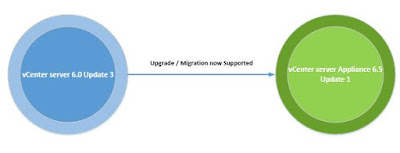vSphere 6.5 Update 1 is now available and it has some great enhancements. While we have seen 5 patch releases so far, 6.5 Update 1 rolls all of those updates together as well as includes some long awaited functionality.
General Updates and Enhancements
vSphere 6.5 Update 1 allows customers who are currently on vSphere 6.0 Update 3 to upgrade to vSphere 6.5 Update 1. All of the security and bug fixes that were part of 6.0 U3 are now included in 6.5 U1 whereas before, upgrading from 6.0 U3 to 6.5 prior to U1 would have put customers in a more risky position due to the timing of the releases. That concern is a thing of the past now, though, and we anticipate even more customers will begin their upgrade journeys.
It is important to note that customers who are still on vSphere 5.5 will need to be on at least vSphere 5.5 U3b in order to upgrade to vSphere 6.5 U1. This may mean a two-step process for some customers to get to vSphere 6.5 U1 but this is necessary in order to ensure the best possible outcome for the upgrade.
vCenter Server
vSphere 6.5 Update 1 we’re increasing some of the maximums configuration.
- Maximum vCenter Servers per vSphere Domain: 15 (increased from 10)
- Maximum ESXi Hosts per vSphere Domain: 5000 (increased from 4000)
- Maximum Powered On VMs per vSphere Domain: 50,000 (increased from 30,000)
- Maximum Registered VMs per vSphere Domain: 70,000 (increased from 50,000)
With the increasing use of hybrid and private clouds, the increase in capacity comes at a crucial time.
vSphere Client
vSphere Client can be accessed via https://<vcenterfqdn>/ui and it is completely built on HTML5, requires no plugins, and it lightning fast. If you’ve been following along with the Fling version, the version in vSphere 6.5 Update 1 is roughly equivalent (actually a bit newer) than the bits in v3.15 of the Fling. You can view the items that we’re still working on getting into the vSphere Client.
vSAN 6.6.1
- vSphere Update Manager (VUM) Integration: The manual process of checking the VMware Compatibility Guide to ensure the upgraded version was supported with the specific hardware has been automated with a completely new Update Manager workflow.
- Performance Diagnostics: The vSAN Cloud Analytics capabilities have been improved with a proactive Performance Diagnostics feature that analyzes the performance of a given vSAN cluster against previously executed benchmarks.
- vSAN Licensing for ROBO and VDI: VDI and ROBO licensing editions are expanded with an Enterprise model that allows encryption and stretched clusters.
I hope this has been informative and thank you for reading!





No comments:
Post a Comment